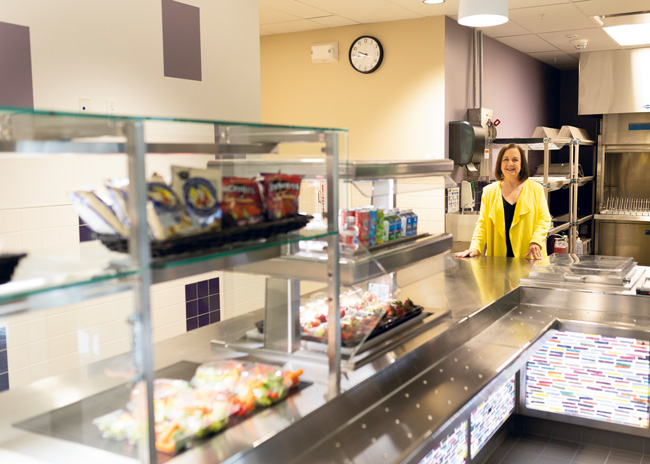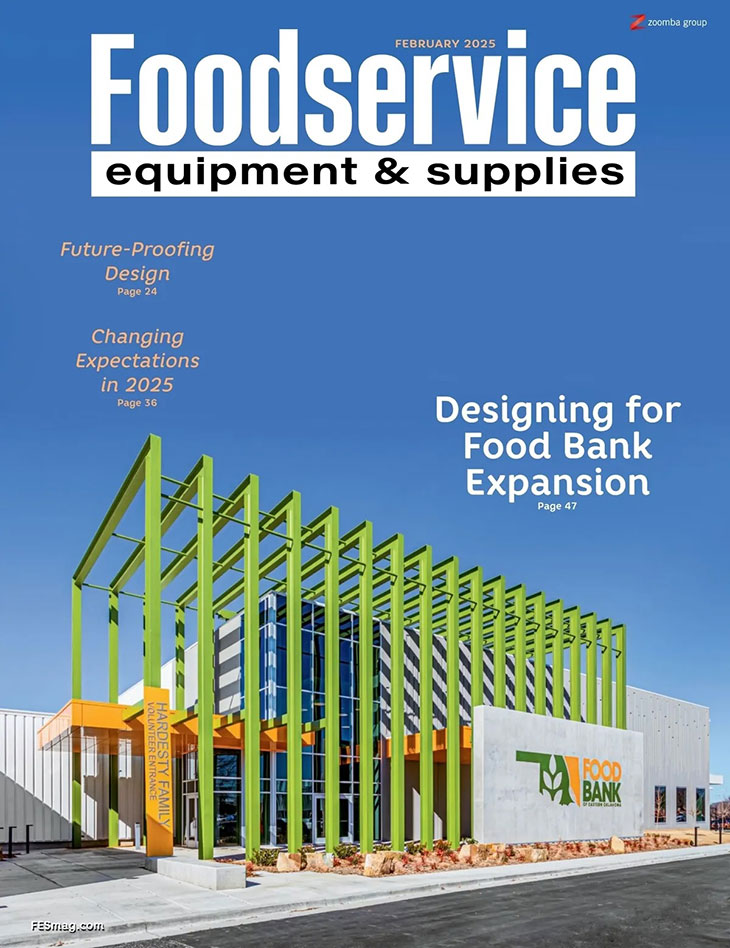Beth Wallace, the current president of the School Nutrition Association, and director of Food and Nutrition Services at Jefferson County School District in Lakewood, Colo., oversees 138 full-service kitchens for the district. The district serves an average of 10,000 breakfasts per day and 33,000 lunches.
The plan is to develop and build a large central production kitchen. At the moment she also has one major middle school “gutted down to the core,” with two brand-new elementary school kitchens being built.
“I’m an unusual foodservice director in that my love is kitchen equipment and design,” says Wallace, who estimates she’s built 30 to 40 kitchens during the course of her career. “The design and remodel of kitchens take several years. Two years ago when we started these projects I wasn’t thinking about the labor crisis I’m having right now.”
Although Wallace says her district is fortunate to not be understaffed, the current industry-wide labor shortage is what got her thinking even more seriously about a central production kitchen. Central production kitchens, aside from concentrating labor in a district, also allow operators to do more from-scratch cooking. This would also allow Wallace to design the main kitchen according to her vision.
“When you have 130 different [kitchen] sites, that means maybe 10 or 12 people came before me and had different ideas of designing and building a kitchen,” she says. “When I started in this business 25-plus years ago, I was in a much smaller district and able to have all 16 of those schools be built exactly the same design-wise and with all the same equipment. It was easy to plan and execute menus and do more scratch-cooking. That gets more challenging with scale.”
For now, Wallace’s immediate needs are to remodel the various kitchens, starting with the most outdated first. Some more contemporary design and equipment choices include adding a walk-in freezer and/or cooler in kitchens that don’t currently have them and implementing beverage merchandisers instead of “milk boxes” to hold bottled water, yogurt parfaits, fresh salads and more. “I can’t live without these merchandisers,” says Wallace.
 Beth Wallace, who oversees 138 full-service kitchens in her school district in Colorado, opts for a sleek, well-lit serving line when updating K-12 foodservice spaces. Photo courtesy of Catherine Jeter Photography
Beth Wallace, who oversees 138 full-service kitchens in her school district in Colorado, opts for a sleek, well-lit serving line when updating K-12 foodservice spaces. Photo courtesy of Catherine Jeter Photography
She also prefers a sleek and well-lit serving line with pops of color — a break from the stainless steel, institutional appearance of years ago. Ideally, her self-serve line would feature a flat serving surface that heats from the bottom, paired with top-down heating elements, such as heat lamps. This approach can contribute to greater menu innovation too. “Even if I can put tiles over wells and have a heat lamp above, I can put pizza on that, and now it’s a pizza display.”
Back lights, unique tiling, and digital menu boards also help brighten up the line and add visual interest. Wallace always puts a drop-in well for ice cream — it’s kids we’re serving here, after all. “I want kids to walk in and say, ‘Wow, this is cool,’” she says. “I love to visit restaurants, hotels, even c-stores and grocery stores to see what type of equipment they’re using and what they’re serving because I want my kids [customers] to feel like they’re walking into a cool place to eat.”
When it comes to developing the design and thinking about the equipment, Wallace takes an approach that might veer from how foodservice consultants design other types of kitchens in that she doesn’t start with the menu. “I think more about flexibility and being able to change things up while still making it look like we planned for that all along; my menu is different from year to year.”
The most flexible pieces of equipment for Wallace include serving wells that can be hot, cold or frozen. “One day I might want to display fresh fruit but also put out a beautiful tray of hot rolls,” she says.
In the back of the house, while combi ovens offer plenty of flexibility cooking-wise, “I don’t buy combis because I’m working with food products where the entree at highest-end value is $1,” Wallace says. “The workhorses I need are steamers and convection ovens — those are tried and true and keep our kitchens going. We will create recipes that can use either so the staff has flexibility. For example, with beef patties, you can put them in the oven on a sheet pan or stack them in a steamer.”
Holding capability is also key when it comes to Wallace’s preferred equipment. “I do believe in really good holding cabinets, both hot and cold. We use them as pass-throughs from the kitchen to the serving line because when you’re serving up to 500 or 600 kids, you have to have the ability to hold and hold well.” Warming cabinets also provide Wallace’s team with the flexibility to hold food with or without added moisture, depending on the product.
A key design feature Wallace thinks about is removing the condiment/napkin/silverware cart from the line and placing it closer to the dining area to keep the students moving through the servery. “Even though it’s on wheels, we don’t move it a lot to tell you the truth — there has to be storage underneath where we can keep backup supply.”
Looking for more? Check out these articles:
K-12 Foodservice Learning from Established Commissary Model in Louisville, Ky.




